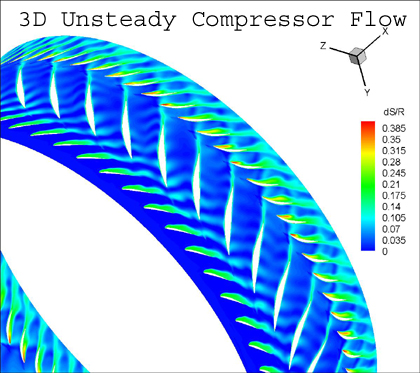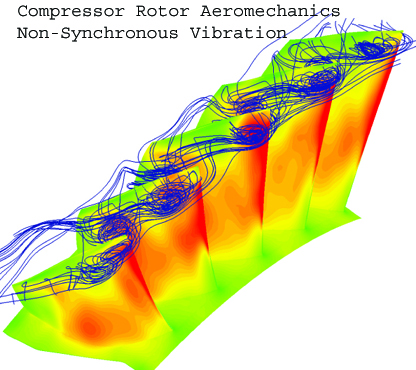


Turbomachinery aeromechanic problems are very challenging since they involve both aerodynamics and structural vibration. Blade vibration due to forced response and utter have been studied for decades to improve turbomachinery e ciency and reliability. Recently, a new turbomachinery aeromechanic problem, namely non-synchronous vibration(NSV), whose blade vibration frequency is away from harmonics of rotor shaft frequency, has attracted a lot of attention. NSV typically occurs without resonance to the rotor blades but can occur close to an eigenmode.
We simulate the non-synchronous vibration (NSV) of a high speed axial 1-1/2 stage compressor using a fully coupled fluid-structural interaction (FSI). Time accurate Navier-Stokes equations are solved with a system of 5 decoupled structure modal equations in a fully coupled manner. A 3rd order WENO scheme for the inviscid flux and a 2nd order central differencing for the viscous terms are used to resolve nonlinear interaction between vibrating blades and fluid flow. A $1/7$th annulus sector is used with a time shifted phase-lag (TSPL) boundary condition to reduce computational efforts. A fully conservative rotor-stator sliding boundary condition is employed to accurately capture unsteady wake propagation between the rotor and stator blades. The predicted NSV frequency agrees with the experiment quite well. The blade vibration is torsionally coupled with highly oscillating blade pressure and is not damped out during the NSV. The tip tornado vortices that travels circumferentially appear to be the main cause of the NSV observed in this study.
The above plot on the left is the entropy contours at the mid-span of the 1-1/2 stage compressor. The animation shows that the wakes of IGV propagate downstream and interact with the rotor(click to see the animation). The plot in the middle is the NSV frequency of the pressure oscillation at 78% span. The predicted frequency of 2646 agrees excellently with the measured frequency range from 2600 to 2660. The structure vibration has the same frequency. The plot on the right is the pressure contours with the streamlines near tip region showing the tornado vortices with the vortex axes normal to the blade suction surfaces(click to see the animation). The mechanism seems to be that the forcing oscillation induced by the traveling tornado vortices excites the NSV. However, NSV is also considered as a phenomenon phase-locked to a structure eigenmode. More study is needed to examine the fundamental mechanism. More details on the numerical simulation of the NSV can be seen in the papers in the publication section of this webpage.